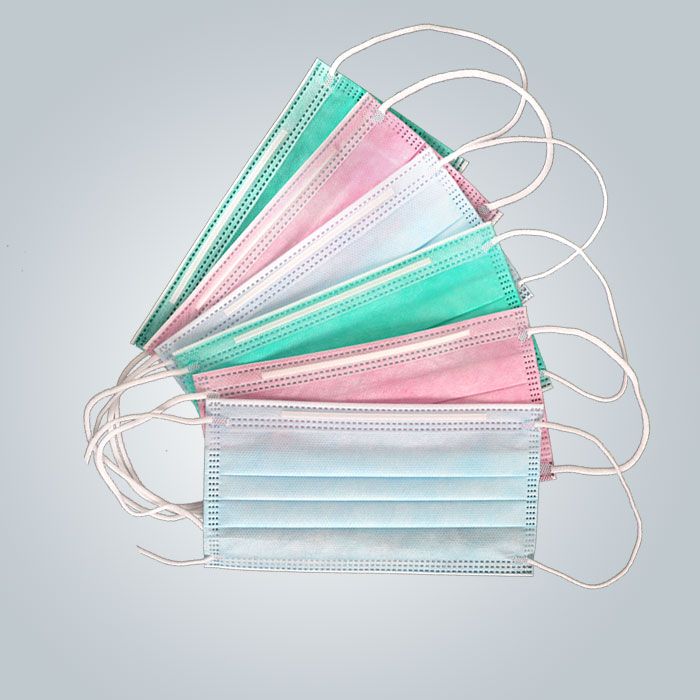What are the classifications of Face masks?
1. Ordinary gauze Face masks. For civilian use, it belongs to the textile category.
(1) Gauze masks are not dustproof.
(2) Ordinary gauze masks are fiber masks. The flow blocking principle is a mechanical blocking effect. Through this layer of mechanical blocking, large particles can be blocked, but particles with a diameter of less than 5 microns cannot be blocked.
(3) Compared with other masks, gauze masks are more advanced, so they are also called anti-virus masks. They have very good anti-virus and dust-proof effects. They are generally used in dust-producing factories and some dangerous rescues.
2. Medical Face masks.
The medical mask is composed of a mask face and a tension band. The face of the mask is divided into three layers: inner, middle and outer. The inner layer is made of skin-friendly material (ordinary sanitary gauze or non-woven fabric), and the middle layer is an isolation filter layer (ultra-fine polypropylene). Fiber meltblown material layer), the outer layer is a special material antibacterial layer (non-woven fabric or ultra-thin polypropylene meltblown material layer).

According to performance characteristics and scope of application, medical masks can be divided into: medical protective masks, medical surgical masks, and ordinary medical masks.
(1) Medical protective masks: Medical protective masks are suitable for the protection of medical staff and related staff against airborne respiratory infectious diseases. It is a kind of self-priming and filtering medical protective equipment with high protection level, especially suitable for Wear it when contacting patients with respiratory tract infections that are transmitted through the air or through droplets at close range during diagnosis and treatment activities. It can filter particles in the air and block droplets, blood, body fluids, secretions, etc. It is a disposable product. Medical protective masks can prevent most pathogens such as bacteria and viruses. The WHO recommends that medical staff use protective masks against particulates to prevent virus infection in the hospital air.
(2) Medical surgical masks: Medical surgical masks are suitable for basic protection of medical staff or related personnel, as well as protection to prevent the spread of blood, body fluids and splashes during invasive operations. The protection level is medium and it has certain respiratory protection performance. It is mainly worn in a clean environment with a cleanliness level of 100,000 or less, working in an operating room, nursing patients with immunocompromised function, and performing body cavity puncture operations. Medical surgical masks can block most bacteria and some viruses, prevent medical staff from being infected, and at the same time prevent the direct discharge of microorganisms carried in the breath of medical staff, posing a threat to patients undergoing surgery. Medical surgical masks require a filtration efficiency of more than 95% for bacteria. Disposable medical surgical masks should also be issued to suspicious respiratory patients to prevent the threat of infection to other hospital personnel and reduce the risk of cross-infection, but the effectiveness of preventing infection is not as good as medical protective masks.
(3) Ordinary medical masks: Ordinary medical masks are used to block sprays from the oral cavity and nasal cavity, and can be used for disposable hygiene care in ordinary medical environments, with the lowest level of protection. Suitable for general sanitation and nursing activities, such as sanitation, liquid preparation, and cleaning
3. Daily-use protective Face masks are mainly used to prevent smog.
4. Dust masks and oily fume Face masks (scientific name: self-priming filter anti-particulate respirator) are generally used for occupational protection. It has better anti-smog effect.
(1) Dust-proof masks are mainly used to prevent dust, smoke, fog, microorganisms, etc. Divided into KN100, KN95 and KN90 grades. Among them, KN10 grade can effectively prevent the ultrafine dust rate of more than 99.97%.
(2) Anti-oil fume masks, which mainly prevent oil fume and oil mist, but also prevent dust, smoke, fog, microorganisms, etc. Divided into KP100, KP95 and KP90 grades. Among them, KP100 grade can effectively prevent the ultrafine dust rate of more than 99.97%.
(3) According to the mask style, it can be divided into three types: disposable, duplex half-face mask and full-face mask.

